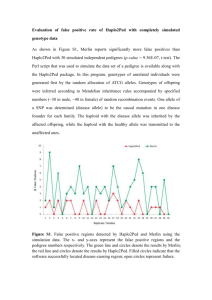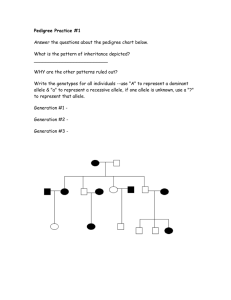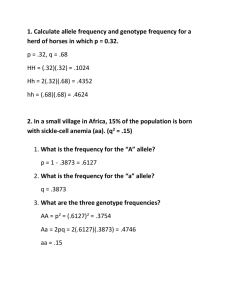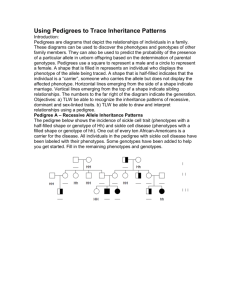Pedigree Scenarios Review
advertisement
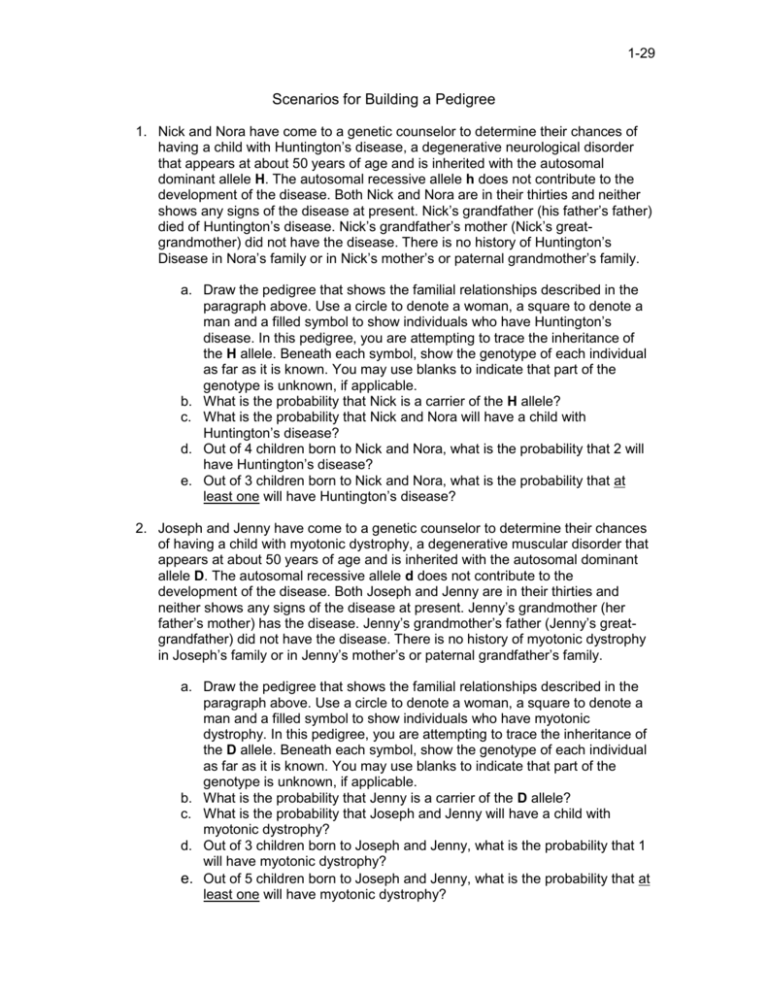
1-29 Scenarios for Building a Pedigree 1. Nick and Nora have come to a genetic counselor to determine their chances of having a child with Huntington’s disease, a degenerative neurological disorder that appears at about 50 years of age and is inherited with the autosomal dominant allele H. The autosomal recessive allele h does not contribute to the development of the disease. Both Nick and Nora are in their thirties and neither shows any signs of the disease at present. Nick’s grandfather (his father’s father) died of Huntington’s disease. Nick’s grandfather’s mother (Nick’s greatgrandmother) did not have the disease. There is no history of Huntington’s Disease in Nora’s family or in Nick’s mother’s or paternal grandmother’s family. a. Draw the pedigree that shows the familial relationships described in the paragraph above. Use a circle to denote a woman, a square to denote a man and a filled symbol to show individuals who have Huntington’s disease. In this pedigree, you are attempting to trace the inheritance of the H allele. Beneath each symbol, show the genotype of each individual as far as it is known. You may use blanks to indicate that part of the genotype is unknown, if applicable. b. What is the probability that Nick is a carrier of the H allele? c. What is the probability that Nick and Nora will have a child with Huntington’s disease? d. Out of 4 children born to Nick and Nora, what is the probability that 2 will have Huntington’s disease? e. Out of 3 children born to Nick and Nora, what is the probability that at least one will have Huntington’s disease? 2. Joseph and Jenny have come to a genetic counselor to determine their chances of having a child with myotonic dystrophy, a degenerative muscular disorder that appears at about 50 years of age and is inherited with the autosomal dominant allele D. The autosomal recessive allele d does not contribute to the development of the disease. Both Joseph and Jenny are in their thirties and neither shows any signs of the disease at present. Jenny’s grandmother (her father’s mother) has the disease. Jenny’s grandmother’s father (Jenny’s greatgrandfather) did not have the disease. There is no history of myotonic dystrophy in Joseph’s family or in Jenny’s mother’s or paternal grandfather’s family. a. Draw the pedigree that shows the familial relationships described in the paragraph above. Use a circle to denote a woman, a square to denote a man and a filled symbol to show individuals who have myotonic dystrophy. In this pedigree, you are attempting to trace the inheritance of the D allele. Beneath each symbol, show the genotype of each individual as far as it is known. You may use blanks to indicate that part of the genotype is unknown, if applicable. b. What is the probability that Jenny is a carrier of the D allele? c. What is the probability that Joseph and Jenny will have a child with myotonic dystrophy? d. Out of 3 children born to Joseph and Jenny, what is the probability that 1 will have myotonic dystrophy? e. Out of 5 children born to Joseph and Jenny, what is the probability that at least one will have myotonic dystrophy? 1-30 3. Galactosemia is a metabolic disorder that results from the autosomal recessive allele g. Individuals who do not have the disease have the dominant allele G. Betty, who does not have galactosemia, marries Bill, who also does not have galactosemia. Betty’s grandfather (her mother’s father) and Bill’s uncle (his father’s brother) have galactosemia. Betty’s grandmother (her mother’s mother) does not have the disease and is not a carrier of the galactosemia allele. Neither of Bill’s paternal grandparents (his father’s mother and father) have galactosemia. There is no history of galactosemia in Betty’s father’s family or in Bill’s mother’s family. a. Draw the pedigree that shows the familial relationships described in the paragraph above. Use a circle to denote a woman, a square to denote a man and a filled symbol to show individuals who have the disease galactosemia. In this pedigree, you are attempting to trace the inheritance of the g allele. Beneath each symbol, show the genotype of each individual as far as it is known. You may use blanks to indicate that part of the genotype is unknown, if applicable. b. What is the probability that Betty is a carrier of the g allele? c. What is the probability that Bill is a carrier of the g allele? d. What is the probability that Betty and Bill’s first child will have galactosemia? e. Out of 4 children born to Betty and Bill, what is the probability that 2 will have galactosemia? f. Out of 3 children born to Betty and Bill, what is the probability that at least one will have galactosemia? 4. Alkaptonuria is a metabolic disorder that results from the autosomal recessive allele a. Individuals who do not have the disease have the dominant allele A. Nancy, who does not have alkaptonuria, marries Norman, who also does not have alkaptonuria. Norman’s grandmother (his father’s mother) and Nancy’s uncle (her mother’s brother) have alkaptonuria. Norman’s grandfather (his father’s father) does not have the disease and is not a carrier of the alkaptonuria allele. Neither of Nancy’s maternal grandparents (her mother’s mother and father) have alkaptonuria. There is no history of alkaptonuria in Norman’s mother’s family or in Nancy’s father’s family. a. Draw the pedigree that shows the familial relationships described in the paragraph above. Use a circle to denote a woman, a square to denote a man and a filled symbol to show individuals who have the disease alkaptonuria. In this pedigree, you are attempting to trace the inheritance of the a allele. Beneath each symbol, show the genotype of each individual as far as it is known. You may use blanks to indicate that part of the genotype is unknown, if applicable. b. What is the probability that Nancy is a carrier of the a allele? c. What is the probability that Norman is a carrier of the a allele? d. What is the probability that Nancy and Norman’s first child will have alkaptonuria? e. Out of 5 children born to Nancy and Norman, what is the probability that 3 will have alkaptonuria? f. Out of 4 children born to Nancy and Norman, what is the probability that at least one will have alkaptonuria? 1-31 5. Ocular albinism is inherited with the X-linked recessive allele a. The X-linked dominant allele A codes for full ocular color. George has ocular albinism. His wife Ginny has full ocular color. Both of Ginny’s parents and both maternal grandparents (Ginny’s mother’s parents) have full ocular color but her great grandmother (the mother of Ginny’s maternal grandmother) has ocular albinism. There is no history of ocular albinism in Ginny’s father’s family. a. Draw the pedigree that shows the familial relationships described in the paragraph above. Use a circle to denote a woman, a square to denote a man and a filled symbol to show individuals who have ocular albinism. In this pedigree, you are attempting to trace the inheritance of the a allele. Beneath each symbol, show the genotype of each individual as far as it is known. You may use blanks to indicate that part of the genotype is unknown, if applicable. b. What is the probability that Ginny is a carrier of the a allele? c. Out of 4 children born to Ginny and George, what is the probability that 2 will be daughters with ocular albinism? d. Out of 3 children born to Ginny and George, what is the probability that at least one will be a son with ocular albinism? 6. Red-green colorblindness is inherited with the X-linked recessive allele c. The Xlinked dominant allele C codes for full color vision. John is colorblind. His wife Jean has full color vision. Both of Jean’s parents and both maternal grandparents (Jean’s mother’s parents) have full color vision but her great grandfather (the father of Jean’s maternal grandmother) is colorblind. There is no history of colorblindness in Jean’s father’s family. a. Draw the pedigree that shows the familial relationships described in the paragraph above. Use a circle to denote a woman, a square to denote a man and a filled symbol to show individuals who are colorblind. In this pedigree, you are attempting to trace the inheritance of the c allele. Beneath each symbol, show the genotype of each individual as far as it is known. You may use blanks to indicate that part of the genotype is unknown, if applicable. b. What is the probability that Jean is a carrier of the c allele? c. Out of 3 children born to Jean and John, what is the probability that 2 will be colorblind sons? d. Out of 4 children born to Jean and John, what is the probability that at least one will be a colorblind daughter?


